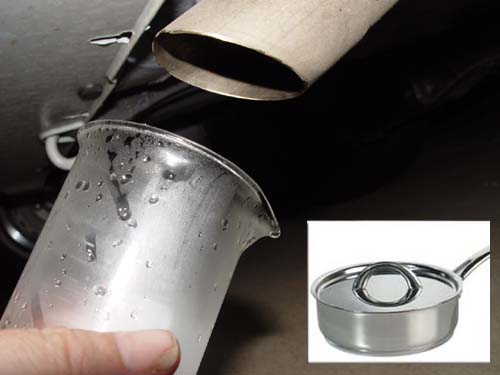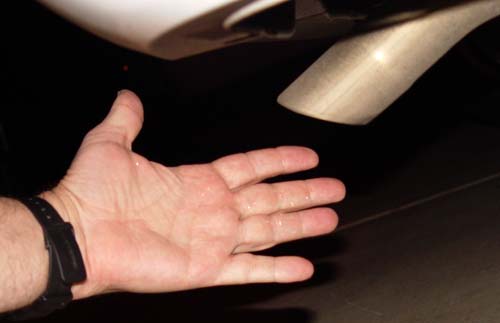Field Lab 5: Global Warming
Detecting water vapor in Car
Exhaust

Car Exhaust contributes a great deal to pollution. It also contributes to global warming by the emission of carbon dioxide and water vapor. The warming isn't from the hot exhaust (which does contribute some) but from the fact that carbon dioxide and water soak up heat from the sun and from heat radiating from the ground.
In this experiment we want to detect water vapor coming from car exhaust. Since in the on-campus lab we proved that combustion produced carbon dioxide, we don't have to do that for this lab.

The source of the water and the carbon dioxide is from the burning of the gasoline in the engine cylinders. Gasoline is a mixture of hydrocarbons with 6 to 10 carbons. Hydrocarbons are chains of carbons with hydrogen atoms attached (see molecule at top of image). In the picture carbon atoms are gray and hydrogen atoms are white.
Gasoline and oxygen enter the cylinder and a spark ignites the mixture. The spark begins the break up of the gasoline molecules and the oxygen molecules. Oxygen starts combining with the carbon atoms to form carbon dioxide (CO2) and oxygen also combines with the hydrogen atoms to form water (H2O). Both of these reactions give off energy. Some of the energy starts the break up of other gasoline molecules, which further allows more oxygen to combine with the freed up carbon and hydrogen atoms. In a flash a trillion trillion gasoline molecules are disintegrated and now just water and carbon dioxide remains.


The key to detecting water vapor from car exhaust is to start with a car with a cold engine.
No, it doesn't have to be this cold.

Evidence of water can be any of the 5 below methods. You only need to take a picture of one of them.
Evidence #1 (cloud): If the air is cold,
the normally invisible water vapor turns to droplets of water and a cloud
forms behind your tail pipe. If this is the case,
just take a picture of your car (or someone's) whose exhaust is showing
the presence of water by condensing into visible water droplets (a cloud). This is only likely in December and January.
 By the
way, if this was burning oil, it would be blue-gray smoke. If it was excess
unburnt gasoline, then it would be black smoke.
By the
way, if this was burning oil, it would be blue-gray smoke. If it was excess
unburnt gasoline, then it would be black smoke.

Evidence #2a (liquid water): Again, detecting water
is best done when a car engine has just started up. (Note: The water is
always there, but when the exhaust is very hot or the weather is hot,
then it's harder to get the water to condense). If the engine
is too hot, then the water will not condense on the tail pipe and
will not be seen. Warning: turn off
engine before taking pictures. If you see water
inside the tail pipe, take a picture.

Evidence #2b (liquid water): On
my friend's Honda, I noticed water spitting from the tail pipe. I first
noticed it by feeling the exhaust from about 1 foot away. Drops of water
was hitting my hand and felt cool as they evaporated. I also could see
drops of water on the driveway. If
you see drops of water on the ground coming from tail pipe, take a picture.
 Again, turn off engine before
taking pictures. I don't want you getting run over by your own car.
Again, turn off engine before
taking pictures. I don't want you getting run over by your own car.

Evidence #3 (Condensation on cool object): If you
can't see liquid water on tail pipe or on the ground, you can try holding
a cool object near the tail pipe. Make sure car
is in park! Here I'm using the 250mL beaker to show that it
fogs up when it came near the exhaust. You can use a regular glass drink glass. A shiny cooking pan might work good too. Note: The condensation may only
last for a few seconds. Just place the glass or metal in the exhaust for
a few seconds and remove it after you see condensation. You might have
time to take a picture before it evaporates. In
hot weather, you may have to put some ice in the beaker.
 This method is almost guaranteed to get visible condensation.
This method is almost guaranteed to get visible condensation.

